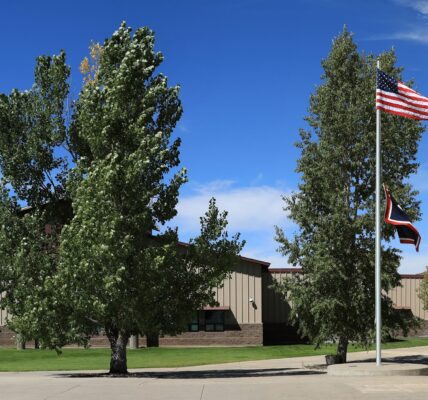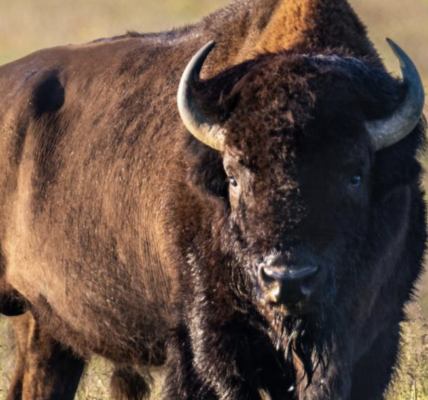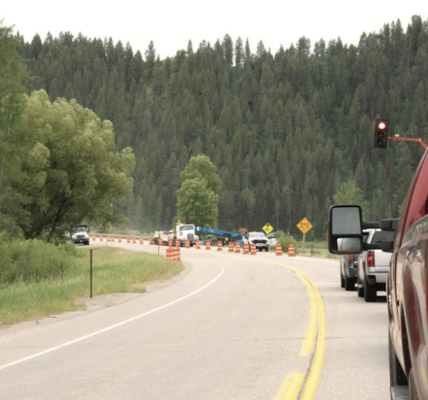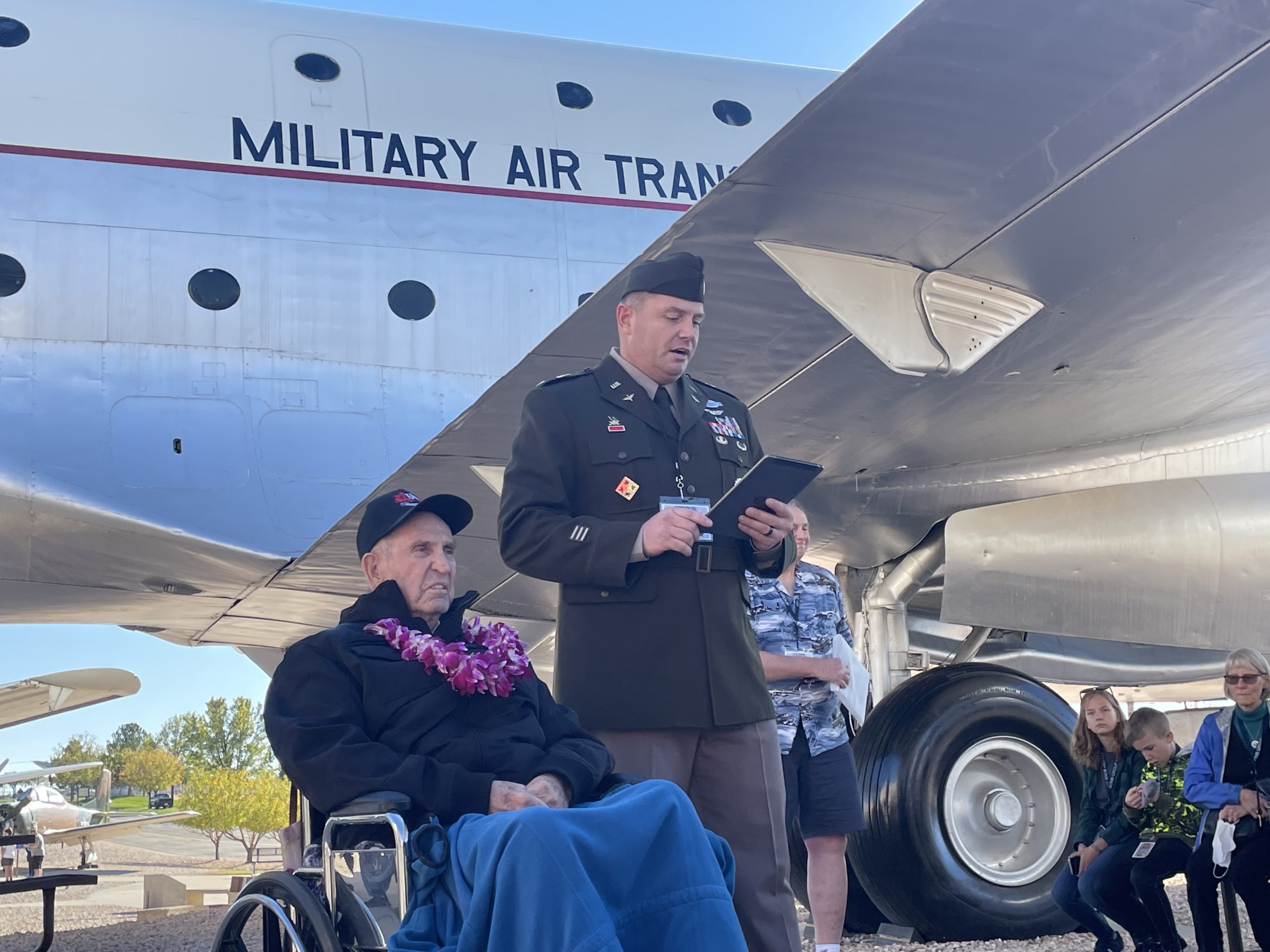
◆ SV Veteran acknowledged for service. Awarded distinguished flying cross.
Editor’s Note: In recognition of Veteran’s Day Thursday, Nov. 11, 2021, SVI Media is publishing the text of a tribute given to Star Valley resident and veteran Wayne Baker. The presentation was given at the 93rd Bombardment Group Association Reunion at Hill Air Force Base in Ogden Utah, Oct. 15, 2021. The presentation was written and presented by Jason Hartley, a grandson to Wayne Baker.
Success doesn’t come from what you do occasionally, but what you do consistently.
Ladies and Gentlemen, I am here today to tell you about a man that vividly brings this quote to life in real world application. My grandfather, Wayne Baker.
CHILDHOOD: Wayne was born in August of 1924, in Star Valley, WY. He was number 5 of 8 children. From childhood, he possessed the fortitude and determination to be successful. During the summers, he worked long days on local farms. In his spare time, he would gather scrap metal to sell. After a rodeo or event at the fairgrounds, he would climb under the grandstands and collect any dropped change.
Wool was very lucrative at the time so he would collect and sell the wool from winter-killed sheep as well as patches of wool caught in barbed wire fences. He would also collect and sell animal bones for glue manufacturing.
During the coldest parts of winter, he would set out in the dark, before school, to set muskrat traps. In the evening, he would tend the traps, and he would spend the weekends processing the catch. All of this was in addition, of course, to working his household chores and tending to the family livestock.
At the age of 16, he received a permit from the forest service to cut cedar posts. He hired 2 kids his age and a 25 year old man to assist him with the cutting, harvesting, and distribution of these posts to local farmers.
WAR: In 1943, Wayne was drafted into the Army Air Corps as an aircraft mechanic and gunner. His military career began with Basic Training in Fresno, California then on to an aviation school in Englewood where the trainees were taught engine and airframe maintenance.
He described this experience as “living high on the hog”. The food was excellent and the private beach attracted the girls. They spent their evenings and weekends at the amusement parks along the beach, or at the shows in Hollywood.
After 21 years in the Army, I can say with confidence, if the Army would adopt this kind of training model we would never struggle with recruiting efforts again. We wouldn’t get any work done…but there would be a lot of us…not doing that work.
But the military being an organization of give and take, his small arms training in Kearns, UT made up for the posh lifestyle they had enjoyed to this point. Here, they were given a cot with a single wool blanket in an open tent and nearly froze to death.
This isn’t important to the story, but it makes me feel better about the whole California thing…
However, the Air Corps did not make them suffer too long, and in short order, they were back living the high life in Las Vegas, NV. Here, they trained in B-17 turrets and waist guns by engaging targets towed behind other aircraft. In addition, they would shoot skeet from a platform attached to a vehicle to learn how to lead targets while in motion.
Upon completion of training, Wayne was assigned to the 330th Squadron, 93rd Bombardment Group.
Incoming aviators and crews had a seemingly impossible task ahead of them. At this time, the required mission count for heavy bomber crews stationed in Europe had increased from 25 to 30. The statistics for survival were bleak. 51% of aircrews were killed on operations, 12% were killed or wounded in non-combat related accidents, and 13% became POWs or evaded. Only 24% of heavy bomber crew members survived the war unscathed. The 30 mission requirement was a lofty goal and the odds were not in their favor.
Wayne’s more memorable missions included bombing runs on the concrete fortified Lorient Submarine shelters, and flying over the Beaches of Normandy to bomb a railway in central France.
During a mission targeting marshalling yards in Munich, Germany, his aircraft had an electric short and released the bombs prematurely, inadvertently destroying a major bomb factory that had been exceptionally camouflaged under a living forest.
Intelligence Officers had spent countless hours sorting through pictures and gathered intel searching for that factory. Their aircraft, however, had lost an engine to flak and Wayne, as the Flight Engineer, quickly calculated the remaining fuel and the rate of fuel consumption for the remaining three engines. He had determined that they had barely enough fuel to make it back to England, but if anything else went wrong, they would crash in Germany.
Some of the crew wanted to reroute to Switzerland since it was closer, but if they landed in the neutral country they would be interned for the remainder of the war. Wayne and the pilots were determined to stay with formation and get back to England. The decision was made to return to base.
They lost the second engine upon reaching the coast of England and the third on final approach to the airfield. The last and final engine ran out of fuel on the runway and their bomber had to be towed out of the way of incoming aircraft. At the end of that mission, Wayne found a piece of shrapnel in his boot that measured approximately ½ inch square and about an inch long.
Many combat veterans have experienced that “one mission” where everything in heaven and hell seem to unite against you. It’s the mission when the reality of war overtakes your youthful perceptions of heroic glory, violently rips you from the confident and arrogant man you were, and slams you into the terrifying reality of your fear and mortality. It’s the moment war becomes “real”.
Wayne experienced this on his 15th mission. While prepping his turret, the gun framework caught on his equipment and collapsed on his arm. Despite the pain, he chose not to inform the crew, as they would possibly have to abort the mission. However, in an unpressurized cabin, altitude aggravates injuries as atmospheric pressure changes. His pain increased tremendously as they gained altitude.
After takeoff, he set about synchronizing the engines, as was his duty as Flight Engineer. As he worked, he spotted another airplane in the distant 12 o’clock position but paid it no mind. The Pilot was busy with post takeoff reports while the copilot was focused on assuming position and maintaining formation flight.
Wayne describes the experience as “something suddenly bothered me” and he looked up to discover that the plane was flying directly at them. He grabbed the copilot by the arm and yelled while pointing at the rapidly approaching plane.
The copilot reacted immediately and turned his aircraft’s 110-foot wingspan on its left wing. The bomber beside them also saw the oncoming aircraft and turned on their right wing. The oncoming plane seemed to figure it out just in time to turn on their wing as well and flew between the bombers at a combined speed of 360 mph. It took several minutes to recover the aircraft and resume formation flight.
The group flew out over the North Sea passing Denmark and continued over the Baltic. When they closed on the target area, German fighters attacked the bomber group ahead of them. The P51 Mustang escorts raced from the back of the formation, ejected their auxiliary fuel tanks, and engaged the infamous and seemingly innumerable German fighters.
In the short amount of time it took for Wayne’s bomber group to reach the area of that initial engagement, dozens of aircraft were falling from the sky. He recalls a group of 3 B-24s in close formation going down in flat spins. Planes were going down on fire, or simply exploding in midair.
Parachutes filled the skies, but the men wearing them were falling to a freezing Baltic Sea. The boats launching from the German coast to capture survivors were too little and too late to reach anyone in time.
The group turned South and began their bomb run. When they reached the coast, the flak was so thick that they swore they could walk on it. Wayne saw a burst of flak 30 feet behind the tail, another at 20, and another at 10. He was convinced the next one would be the end of them, but that fatal burst never came.
As they approached the target, another aircraft had positioned themselves directly over them to protect itself from the flak bursts below. The bomber overhead opened its bay doors and Wayne alerted the pilot. They moved over just in time, and the bomber released its payload, just missing the tail of Wayne’s aircraft below.
After the bombs were released, the formation turned back to England. Wayne sat back and shut his eyes in relief.
Something got his attention and he opened his eyes just in time to see a propeller blade spinning inches above the dome of his turret. He hit the intercom button, but was so terrified that he was unable to speak.
He pulled the emergency release on his seat, plummeting him to the flight deck behind the pilots, and pushed the controls hard forward putting the plane into a dive. The plane shuttered and it became clear that they had struck something.
Neither pilots knew what had happened, and immediately tried to regain control of the diving B-24 without tearing off the tail section, as these aircraft were prone to do. Wayne had to sit back for several minutes to calm himself and regain his faculties. Once the aircraft was under control, he was able to communicate what had happened, and the offending airplane was far in the distance.
From his turret, he was able to see that the impact had flattened the top 10 inches of their rudders. Their use of the rudders for directional control was lost, and they had to change engine power on either side to compensate. I want to use Wayne’s own words to describe his state after this mission. In his book he wrote:
For me it had been a flight filled with sheer panic most of the trip. It was a long mission, about nine hours. The flak scared the hell out of me and this airplane setting down on us scared me to where I couldn’t talk.
After that mission, I went to the Flight Surgeon and told him I wouldn’t fly anymore. He explained to me that my panic attacks and extreme pain in my arm were symptoms of Anoxia brought on by lack of Oxygen. Once I understood this, I agreed to continue to fly.
It was a hell of a day.
Wayne was awarded the Distinguished Flying Cross for his actions that day. Of the 35 planes in the bomber group ahead of them, only one returned to England. I would alter his expression from “it was a hell of a day” to “it was a day in hell”.
He completed his allotted missions in August of 1944. He flew 32 missions and logged 181.5 combat hours. He was, of course, physically and mentally exhausted, but he knew his service had been worthwhile.
At the age of 19, he was keenly aware of the rights and liberty for which he fought. Throughout his life, he pursued that freedom and fought those that challenged it.
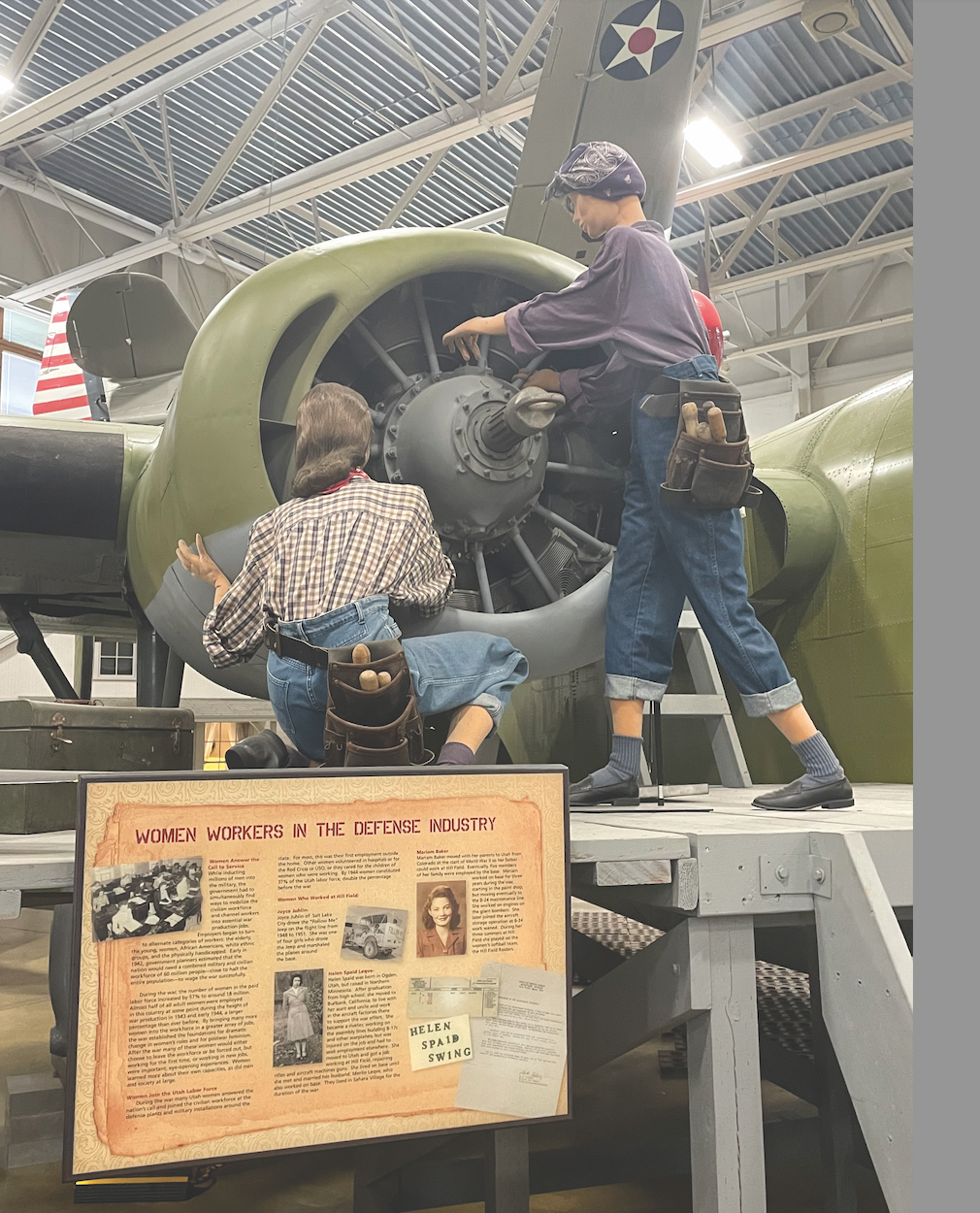
MARIAM: When he returned from overseas on furlough, he stopped to visit his cousin in Ogden, UT. His cousin had a date that night and asked Wayne to join him and accompany his date’s sister, Mariam Meister. As they pulled up to the house to pick the girls up, Mariam was elbow deep in dishwater and had not had the chance to shower or change clothes.
She was a mechanics helper, working on B-24s, here at Hill Air Force Base. Still in her greasy clothes, she was drug out to the car to meet Wayne. They went out for the evening and all reports confirmed they had a good time.
Wayne was transferred to Buckley AFB in Denver, CO. When he had some time off he went to Ogden to visit Mariam. About a year had passed since their first date and he had developed more than a casual interest in her. He was able to work the system to where he would hop flights back and forth between Hill and Buckley AFB. As time went on, he spent more time in Ogden than he did in Buckley, despite her father’s concerns of Wayne being charged as AWOL.
On Wayne’s 21st birthday , August 15th 1945, the Japanese gifted him, and the rest of the world, with complete surrender. As Wayne traveled to California to be discharged, he stopped in Ogden where he and Mariam were married in the living room of the Meister home. He was discharged on October 11, 1945 and the newly formed Baker family set off for adventure.
Wayne and Mariam faced the many challenges of starting a new family with a do-it-yourself attitude. They built their own homes on the side while working full time jobs. They were an entrepreneurial family from the start.
ENTREPRENEUR: Wayne is uncannily gifted with the ability to see an opportunity, seize the moment, and capitalize on the endeavor. After attending an auction at a closing coalmine with his father-in-law, he created a business where he would go to defunct mines and buy, salvage, and resell the scrap and machinery. He could buy very low and with a little, or a lot, of elbow grease, turn a substantial profit.
This salvage operation grew into a full time business named Mountain States Machinery. As the business grew, his travel requirements increased. He bought a 182 Cessna airplane and got his private pilot license. With his new freedom of maneuver, he was able to fly to customer’s mines, fly the owner back to his supply yard, make the sale, and return them to their mine without significant delay in their daily production.
The profits that resulted from his first sale nearly paid for the plane in full. In a short amount of time, Mariam also became licensed, and she would fly when Wayne was unavailable. In 1967, Mariam and Wayne were awarded the Industrial Achievement Award of Utah for the most aggressive development of a company that year.
In the course of his salvage operations at a particular mine, the owners pursued the sale of the property where his scrap was located. Wayne bought the land in order to continue to salvage and protect his investment. The main office of his primary customer decided that they would no longer do business with him because he now owned coal property. By definition, he was now a mine owner and that made him a competitor.
Having little interest in mining, he offered to sell them the property, but they refused. With the loss of his main client, he would lose his salvage business. In his frustration and hardheaded determination, he stood up and said, “Gentlemen, I am now in the coal business.”
He contacted investors and together they created the Plateau Mine. Wayne knew little about running a mine so a friend was brought in as manager. Wayne helped with business operations, construction, and engineering new and inventive methods and machinery such as a coal chute that carried the coal down the mountainside instead of the time consuming mine cars or dump trucks.
In short order, the mine was the greatest producer per man-hour in the country. Three years later, they sold the business for a 1300% profit.
When they sold the mine, Wayne and Mariam invested in Rocky Mountain Arms, a mini-revolver manufacturer. The company was poorly managed and was eventually closed down.
Wayne and Mariam bought the equipment from the closed business and began manufacturing the .454 Cassull, designed by the highly gifted gun designer, Dick Cassull. It was the most powerful handgun of it’s time. This venture was named, Freedom Arms, and remains Wayne’s pride and joy to this day.
They opened the Freedom Arms factory in Star Valley, WY and developed a highly skilled workforce. Over the years, Freedom Arms expanded their manufacturing to include various calibers and designs with the highest attention given to precision and quality. Freedom Arms pistols are highly sought after by gun collectors and enthusiasts around the world. In 1994, Wayne retired as President and CEO, and his son Bob Baker succeeded him.
After stepping down from his CEO role, Wayne continued working. Friends asked him for help with various steel fabrication projects. He began building truck beds, cattle guards, and bridges as well as selling culverts and other iron products.
Wayne has built roughly 100 bridges since the 1970s. He was over 90 years old when he designed his first arched bridge. The bridge was 12 feet wide and 112 feet long. In order to compensate for his lack of education in mathematics, he laid out the metal in the design he wanted on the ground and measured the angles.
His grandson arranged for Wayne to meet with the head of the College of Engineering at the University of Wyoming, who looked at the plans, made a couple of small changes, and pronounced the design sound.
In order to provide their students with the tools needed to build their own business outside of the engineering firms, the College created an entrepreneur class. Wayne’s autobiography is used as one of the textbooks for the class.
FAMILY: Wayne and Marium have been blessed with 8 children: Connie, Alan, Christine, Claudia, Robert, Susan, Don, and Bonnie. Alan was tragically lost at the age of 18 in a car accident. His loss was felt deeply in the family. Wayne’s children married and began families of their own. To the best of my knowledge, Wayne currently has 41 grandchildren, 102 great-grandchildren, and 15 great-great grandchildren.
Mariam passed on January 23, 2018 and is sorely missed, but fondly remembered, by our family.
CLOSE: Ladies and gentlemen, as I close, I wish to express my gratitude for the opportunity I have been given to stand before you today. I would like to recognize Aunt Connie individually for her contributions and support with this program.
Thank you for your attention, patience, and indulgence as I shared just a small portion of my grandpa’s stories with you. Thank you.



